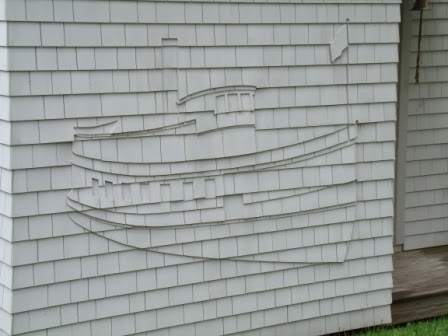Time
for another Ferryboat ride. This time I took the island scenic tour of
Casco Bay (Portland, Maine). 6 hour ride for $25. First the ferry
itself:
As
usual, I spent a lot of time talking with the captain. These are rather
touristy looking crafts, BUT, they have a very clever design feature.
Weight. Wait, weight? Yup, the ferries were designed by the naval
architect to be just a couple hundred pounds shy of 300,000 pounds.
Sounds ridiculous until you find out that a skipper holding a 100 Ton captains
license can drive a boat up to 150 tons (300,000 pounds). If that weight was
exceeded - the ferryboat company would have had to hire a captain holding a 500
Ton Master Mariner license. 500 ton captains are twice as expensive as a
100 ton captain (not 5X like you might think).
Tech
note – it’s powered by a single, old, naturally aspirated, Detroit 8V71 that
has been rebuilt many many times. No bow or stern thrusters – making them
tricky to dock in a cross wind. They are ferries (after all) and take no
offense if you bash them into the pier during docking. Since they’re
steel, the pier gets the worst of it.
Casco
Bay
has a rich history. Casco Bay is a very large, deep water port.
This, of course, worked against the poor Indians who just appreciated bountiful
fishing. Since it was such a strategic spot it got the attention of the
settlers early on. Translation – there aren’t a lot of Indians (or fish)
left.
Unfortunately
the day I chose was rainy (so some of the pictures you see here I stole off the
web).
It
gets its name from its small size (only a lousy 6th order Fresnel
inside) and was modeled after some Greek piece of crap ( the Choragic
Monument of Lysicrates, built in Athens, Greece, in the fourth century
B.C.. Click on it if you must know. Personally I think these emails are
boring enough without drilling down into ancient monuments.) It was
built in 1837 at a cost of $3,500. What I found amusing was that it sits at the
end of an 1,800 foot breakwater and they did not provide for a place for the
poor lighthouse keeper to live. They figgered “screw him; let him walk
out from the town”. This was a mistake as the money they saved by not
building a lighthouse keepers quarters they wasted placing want ads in the
newspaper. They needed someone dumb enough to walk out on ice covered rocks in
the middle of winter to light the lamp. Eventually storms wrecked the original
lighthouse and they rebuilt it with a more substantial structure. That
did pretty well until some idiot dredging operator cut the power cable.
At that point they gave up and turned the job over to GPS.
During
WWII, 274 Liberty ships were built there. Hence the memorial at the beginning
of the breakwater.
The
ferry ride takes you past Cushing Island. On a clear day this would have been
interesting as the landscaping on Cushing Island was done by the same guy that
did Central Park in NY (no idea if it’s as easy to get mugged or stabbed out on
Cushing Island. I wasn’t taking any chances and transferred my wallet to my
front pocket). As it was rainy, this is what you first see of the island:
As
you continue, however, this comes into view.
 |
| This is the old man of Whitehead (has the square jaw of an Indian chief if you ask me) |
See
it? Yeah, me neither. It’s another goddamn lighthouse:
What
makes this one interesting is that good ole George Washington himself
commissioned it back in 1780. They built it for $750. They were real tightwads
back in those days and only paid the keeper $13 a month (but let him keep all
the fish he could catch).
Ft
Gorges came into being when the British showed us in the War of 1812 just how
vulnerable the port was. It was completed by the end of the Civil War
(good timing). When they finished building it they realized that, even though
it’s made out of granite, it would be toast against an explosive shell.
During WWII they used Ft Gorges to store mines. Today it’s a good place
for a picnic, BUT, stay off the ramparts. Those nice looking green bushes are
actually:
Poison Ivy, lots of it.
Large
amount of WWII history in Casco Bay. As it turns out, Casco Bay was the
starting point of the shipping convoys to England. It was not unusual to
see 100+ Liberty ships at anchor waiting to form up into a convoy. As it
was such a strategic area, it’s dotted with lots of concrete observation
towers:
You
can find these towers all up and down the coast of Massachusetts as well.
I think they’re cool and would make a great condo, but I’ve never seen that
done so I must be missing something. God knows each one has a spectacular view.
The
next obvious step from building an observation tower is to find a way to deal
with the enemy you just spotted. Most of the time they were spotting U-boats
and those fights were left to the Navy to handle. Someone, however,
worried about what they would do if the Navy wasn’t immediately
available. Some genius decided it would be a good idea to place a big
piece of artillery in one of the forts. Somehow they managed to get their hands
on an uninstalled 16 inch battleship gun.
On
paper this sounded like a good idea. Nothing like being able to lob a
2,300 pound shell 24 miles. What no one took into account was the concussion
a 16 inch naval gun belches out. They fired the gun one time and one time
only. The firing of that gun broke every single window in Portland.
On
to another fort - Ft Scammel (yeah, I know, these forts are getting as boring
as lighthouses) which is on House Island.
It was an unremarkable fort, for the most part, until it became the site of an immigration quarantine station from 1907 to 1937, and was considered the 'Ellis Island of the North'. The quarantine station was busiest in the early 1920s. The 1920 brick detention barracks have been demolished, but the original 1907 buildings remain, including the doctor's house, the detention barracks, and the quarantine hospital. On June 21, 2012, the WSJ reported the island for sale for $4.9M.
If you remember Admiral Peary
(kinda looks like Stalin if you ask me)
First guy to go to the geographic north pole in 1906 – (somewhat disputed, but so what if he missed it by 5 miles) this was his summer home
What I failed to get a picture of is the tiny island right next to it. This is where he kept his sled dogs. According to local folklore, when the dogs got too noisy, Admiral Peary would go out on the deck and yell at them through a megaphone. Liked to have seen that. Too far to hit ’em with a shoe.
The ferry stops for lunch at Bailey “Island”. The “island” is actually connected to the mainland by road, so technically is should be Bailey “Peninsula” I suppose. Getting to Portland via ferry is 3 times faster than driving. The island is famous for its unique bridge.
Some of the houses on the island are pretty cool. At first I thought the side of the shed had water damage:
Not so:
Boat for sale (cheap)
The thing that’s disconcerting about Maine is just how much money is there:
This is just a tiny part of an island that is owned by one guy. It comes complete with barn, wild livestock, main house, guest houses, helicopter pad, paved roads, observatory (replete with a $2M telescope), deepwater dock, etc. even with its own church. All that and it’s just a summer home for an architect from NY city.




























